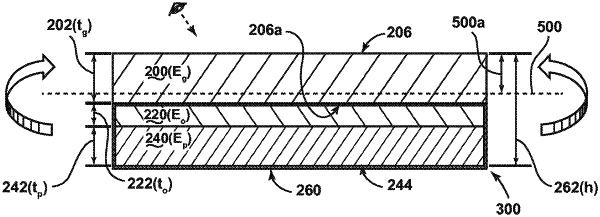| CPC B32B 7/12 (2013.01) [B32B 7/022 (2019.01); B32B 27/36 (2013.01); B32B 37/14 (2013.01); B32B 2307/536 (2013.01); B32B 2309/105 (2013.01)] | 18 Claims |

|
1. A stack assembly, comprising:
a glass element having a first thickness from about 25 μm to about 125 μm, and a first and a second primary surface, the glass element further comprising:
(a) a first glass layer having a first and second primary surface, and
(b) a compressive stress region extending from the second primary surface of the glass layer to a first depth in the glass layer, the region defined by a compressive stress of at least about 100 MPa at the second primary surface of the layer, the compressive stress region comprises a maximum flaw size of 5 μm or less; and
a second layer coupled to the second primary surface of the glass layer having a second thickness, wherein the second layer comprises a composite of polymer and optically clear adhesive (OCA), the polymer of the second layer comprises at least one of polyethylene terephthalate (PET) or polymethyl methacrylate (PMMA), the OCA coupled to the second primary surface of the glass layer, and wherein the thicknesses and elastic moduli of the polymer, the OCA and the glass layer are configured to shift the neutral axis, compared to a position of the neutral axis of the glass layer when not coupled to the second layer, toward the second primary surface of the glass layer when the stack assembly is bent so that the center of curvature is on the side of the first primary surface,
wherein the glass element is characterized by:
(a) an absence of failure when the element is held at a bend radius from about 3 mm to about 10 mm for at least 60 minutes at about 25° C. and about 50% relative humidity,
(b) a puncture resistance of greater than about 1.5 kgf when the second primary surface of the element is supported by (i) an approximately 25 μm thick pressure-sensitive adhesive having an elastic modulus of less than about 1 GPa and (ii) an approximately 50 μm thick polyethylene terephthalate layer having an elastic modulus of less than about 10 GPa, and the first primary surface of the element is loaded with a stainless steel pin having a flat bottom with a 200 μm diameter,
(c) a pencil hardness of greater than or equal to 8H, and
(d) a neutral axis within the glass layer that is located between the second primary surface and half of the first thickness, when the stack assembly is in the bent configuration.
|